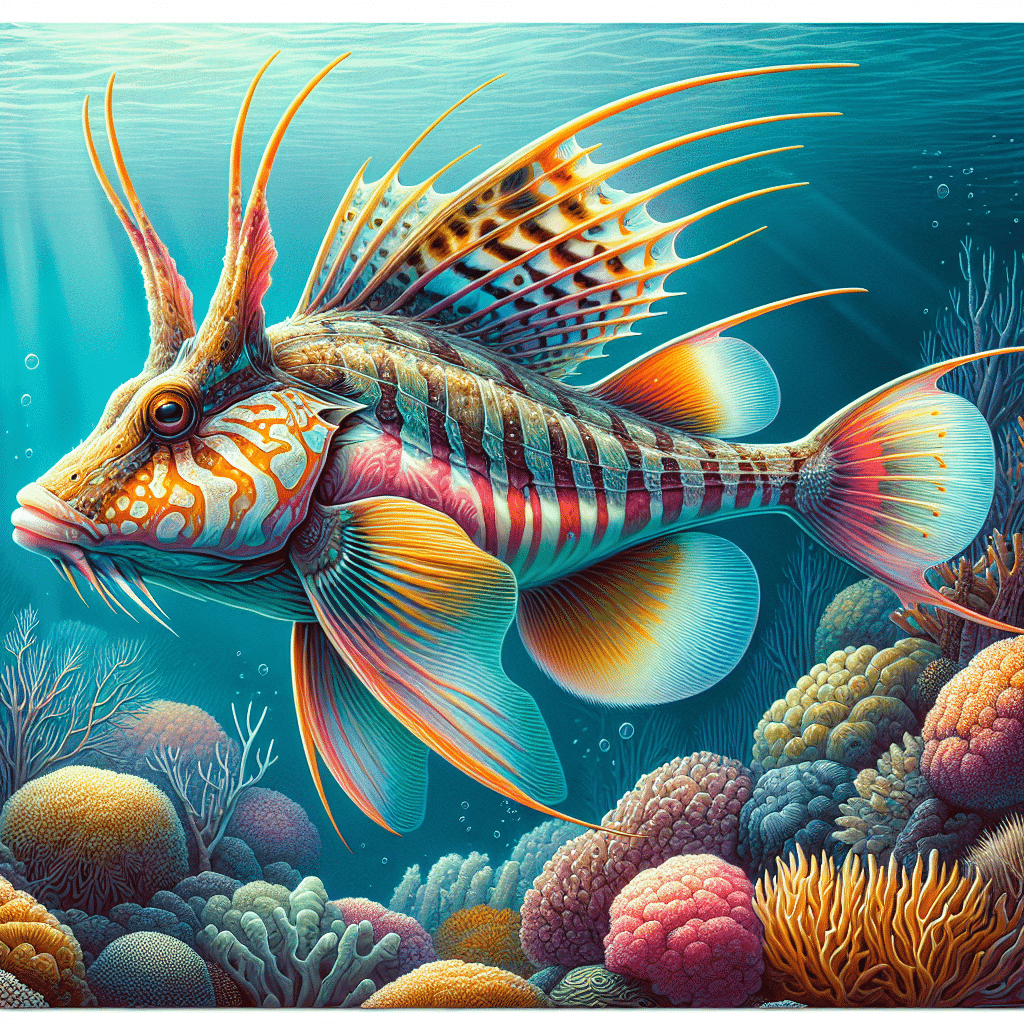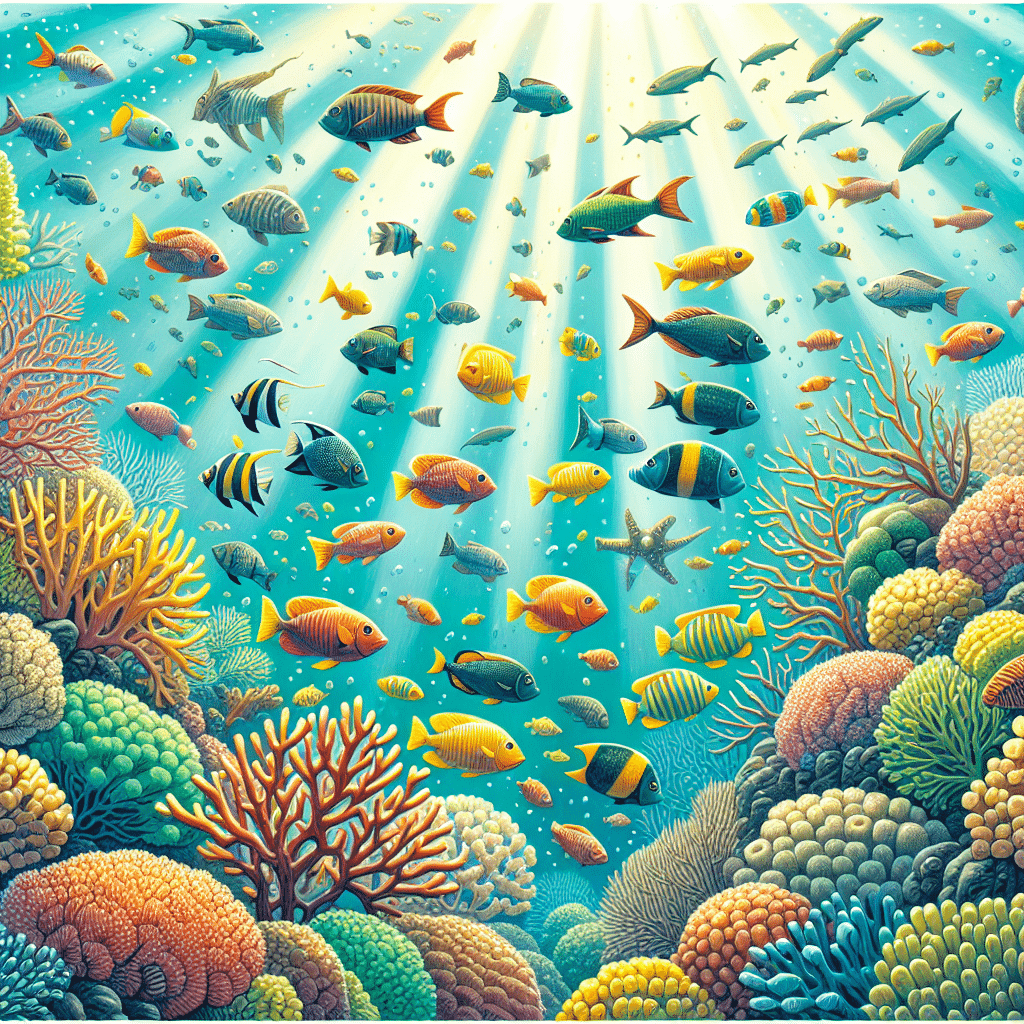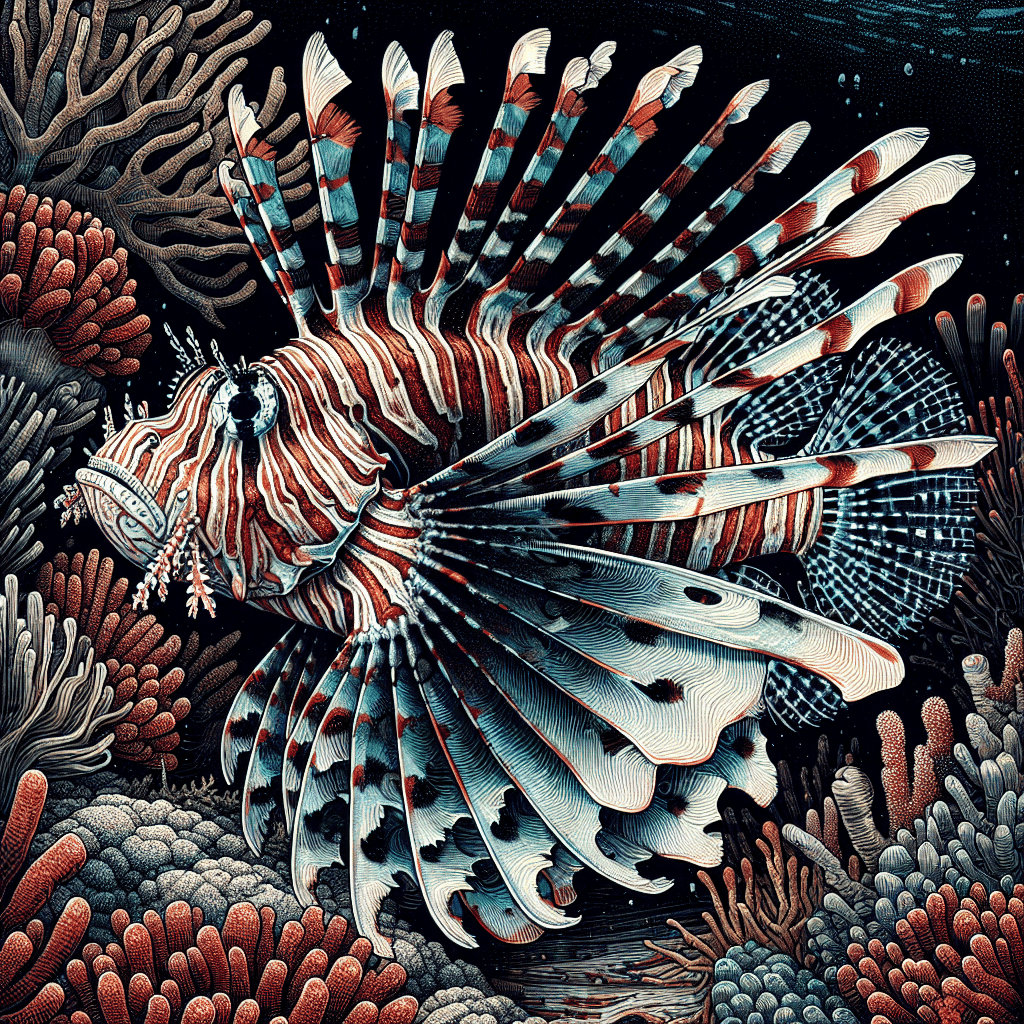Introduction to Rabbitfish
Rabbitfish Species Overview
I find rabbitfish to be fascinating creatures within the world of marine fish. They belong to the family Siganidae and the order Perciformes, boasting at least 29 different species, many classified under the genus Siganus. These fish inhabit shallow lagoons, reefs, and tropical waters of the Indo-Pacific and eastern Mediterranean, ranging from the Red Sea all the way to Tahiti. They typically dwell at depths of 30-100 ft, which means they need to be close to the shore or reefs for grazing on their preferred diet.
Rabbitfish can grow up to 30 cm in length and are usually olive or brown in color. However, certain species exhibit brighter colors like yellow. The foxface rabbitfish, for example, is known for its distinct black stripes on its face. A unique trait of rabbitfish is their venomous dorsal and anal fin spines used for protection, which contain a heat-labile protein venom that can be treated with heat exposure. They even use a color-changing form of camouflage for sleeping or when feeling threatened (DAMSL).
Habitat and Behavior
In terms of behavior, rabbitfish are diurnal, meaning they are active during the day and retreat to rock crevices at night for safety. They are primarily herbivorous but have been observed nibbling on corals, tunicates, sponges, and other sessile invertebrates. One of their notable dietary habits is their consumption of problematic Bryopsis algae, making them a beneficial addition to a reef tank.
These fish are known for their hardiness and disease resistance, which is a big plus for aquarists. Despite their venomous spines, they generally have a peaceful nature, making them suitable for community tanks. In captivity, rabbitfish can live up to 8-12 years, which is quite impressive for reef tank fish (DAMSL).
If you’re considering adding rabbitfish to your aquarium, it’s essential to understand their habitat preferences and behaviors to ensure a thriving environment. For more information on various marine species, check out the sections on tang and clownfish in my articles.
Care and Maintenance of Rabbitfish
Caring for rabbitfish can be a rewarding experience for any aquarium hobbyist. They have unique dietary needs and tank requirements that help them thrive. Here’s what I’ve learned about their care and feeding.
Tank Requirements
When setting up a tank for rabbitfish, size matters. I recommend having a minimum of 75 gallons, depending on the species, to ensure they have enough space to swim and explore. Rabbitfish prefer a well-structured environment with plenty of hiding spots, like rock crevices, where they can retreat at night since they are diurnal.
| Requirement | Recommendation |
|---|---|
| Minimum Tank Size | 75 gallons |
| Water Temperature | 72 – 78°F |
| pH Level | 8.1 – 8.4 |
| Salinity | 1.020 – 1.025 SG |
Maintaining proper water parameters is crucial, as rabbitfish are hardy but still susceptible to poor water quality. Regular water changes and a good filtration system will help keep the environment clean and healthy.
Diet and Feeding
Feeding rabbitfish can be quite enjoyable, as these fish have a varied diet. They are primarily herbivorous but can also enjoy some meaty foods. I usually offer them a well-balanced diet consisting of:
- Algae from natural sources
- Algae sheets
- Flake and pellet diets specifically for herbivores
- Brine and mysis shrimp (occasional treats)
Rabbitfish are known to graze on problematic Bryopsis algae, making them useful in controlling algae growth in the tank. They can also nibble on corals, tunicates, and sponges, so it’s best to monitor their behavior if kept in a mixed reef tank.
| Food Type | Description |
|---|---|
| Algae Sheets | Great for daily feeding |
| Spirulina Flakes | Provides essential nutrients |
| Meaty Foods | Occasional treats (brine shrimp, zooplankton) |
It’s important to ensure that their diet is rich in plant material, as this is essential for their health. I often rotate between dried seaweed and various frozen foods to keep their diet interesting and nutritious.
By carefully managing their tank conditions and diet, I find that rabbitfish can thrive and become a vibrant addition to any reef tank. For more tips on maintaining a healthy aquarium, check out our articles on marine fish care.
Unique Characteristics of Rabbitfish
Rabbitfish are fascinating creatures, and they possess some unique traits that make them stand out in the aquarium world. Let’s dive into their coloration, patterns, and those intriguing venomous spines.
Coloration and Patterns
Rabbitfish can grow up to 30 cm in length and typically have olive or brown coloration. However, some species sport brighter colors, like yellow. For instance, the fox-faced rabbitfish is easily recognizable due to its distinct black stripes on its face. One of the coolest features of rabbitfish is their ability to camouflage themselves. When they feel threatened or while sleeping, they can change their appearance dramatically, adopting a splotchy look that resembles military camouflage. This makes them harder to spot among rockwork and coral branches, which I find pretty impressive (DAMSL).
| Rabbitfish Species | Typical Color | Unique Features |
|---|---|---|
| Common Rabbitfish | Olive or Brown | Camouflage capabilities |
| Fox-faced Rabbitfish | Bright Yellow with Black Stripes | Distinct facial markings |
Venomous Spines
One of the more alarming characteristics of rabbitfish is their venomous spines. These fish possess venom glands associated with their dorsal, pelvic, and anal spines, allowing them to deliver a painful sting if threatened. While this sting can be quite painful, there are no reported cases of serious infections or hospitalizations due to their venom (Reefs). I always advise caution when handling these fish or maintaining an aquarium that houses them.
The venom itself contains a heat-labile protein, which means it can be treated by applying heat to the affected area. This feature adds an interesting layer to their defense mechanism, making it important to be aware of their spines while enjoying these beautiful fish.
In summary, rabbitfish are not just visually striking; their ability to camouflage and their venomous defenses make them a unique addition to any reef tank. If you’re interested in learning more about other marine fish, check out our articles on lionfish or tang.
Breeding and Reproduction of Rabbitfish
Reproductive Behavior
When it comes to rabbitfish and their breeding habits, I’ve found that they have some fascinating behaviors. These fish typically engage in group spawning, where multiple males and females come together to release eggs and sperm into the water simultaneously. This behavior often occurs during the breeding season, which can vary based on environmental conditions like temperature and light.
Rabbitfish are known to be quite prolific, and their ability to camouflage themselves helps them evade predators during this vulnerable time. They can blend into their surroundings, making it harder for potential threats to spot them while they release their eggs. This strategic behavior not only enhances their chances of successful reproduction but also ensures that the next generation has a better shot at survival.
Egg-laying Process
The egg-laying process of rabbitfish is equally intriguing. Female rabbitfish typically lay their eggs in open water, where they can float freely. The eggs are usually adhesive, sticking to various surfaces like rocks and corals once released. The number of eggs can vary, but it is not uncommon to see a female laying thousands of eggs during a single spawning event.
Once the eggs are laid, they undergo an incubation period that can range significantly based on environmental factors. In some cases, the eggs hatch in just a few days, while in others, it may take up to a few weeks. The young rabbitfish, or fry, are initially planktonic and rely on the currents to drift in search of food and shelter. As they mature, they begin to adapt to their environment and start grazing on algae and other food sources.
For those interested in keeping rabbitfish in their aquariums, it’s essential to provide a suitable environment that mimics their natural habitat. This includes ample hiding places and a well-balanced diet that supports their growth and health. If you’re curious about caring for these fish, check out our section on marine fish for more tips and information.
Rabbitfish in Aquariums
Rabbitfish can be a fantastic addition to a reef tank, especially for hobbyists looking for hardy and peaceful fish. Here’s what I’ve learned about their compatibility with other fish and their disease resistance and longevity.
Compatibility with Other Fish
When considering rabbitfish for your aquarium, it’s important to note that they generally have a peaceful nature. They get along well with many reef tank inhabitants, but there are a few pairings to keep in mind. Rabbitfish do best in a community tank with other peaceful fish. Some good companions include:
| Compatible Fish | Notes |
|---|---|
| Clownfish | Peaceful and friendly |
| Tang | Similar habitat and feeding needs |
| Butterfly Fish | Compatible due to similar diets |
| Blennies | Small and non-aggressive |
| Gobies | Peaceful bottom dwellers |
Avoid keeping rabbitfish with aggressive species like triggerfish or lionfish, as they may feel threatened and become stressed. It’s also wise to ensure there are plenty of hiding spots in the tank to help them feel secure. For more information on fish compatibility, check out our resources on marine fish.
Disease Resistance and Longevity
One of the standout features of rabbitfish is their hardiness. They are known to be disease-resistant and can tolerate less-than-perfect water conditions in aquariums (Reefs). This makes them a great choice for both new and experienced aquarists.
In terms of lifespan, rabbitfish can live anywhere from 8-12 years when properly cared for (DAMSL). Their longevity is often supported by a well-balanced diet consisting of algae, flakes, and meaty foods like brine or mysis shrimp. Ensuring their dietary needs are met can significantly impact their overall health and lifespan. If you’re interested in dietary specifics, check out our article on hair straightening products for curly hair.
With the right care, rabbitfish can thrive in your aquarium and provide a beautiful and serene presence.
Ecological Impact of Rabbitfish
Invasive Behavior
Rabbitfish, particularly the tropical species, have been making waves in new environments, especially in the Mediterranean Sea. Their expansion into this region started after the opening of the Suez Canal in 1869, which allowed for a significant influx of tropical fish species. This movement has been largely influenced by ocean currents, and it has led to noticeable ecological changes. I’ve read that the introduction of these herbivorous fish has altered the landscape of algal forests, leading to a shift from rich, diverse ecosystems to barren, deforested areas. This dramatic change results in a threefold reduction of benthic biomass and a 40% decrease in species richness in the affected regions.
As these rabbitfish graze on seaweeds, they significantly impact the local flora. Their herbivorous diet means they can consume large quantities of algae, which can be detrimental to the overall health of marine ecosystems. The deforestation of these algal forests creates a ripple effect, impacting not only the flora but also the fauna that depend on these habitats for survival.
Influence on Marine Ecosystems
The influence of rabbitfish on marine ecosystems extends beyond just the reduction of plant life. Their ability to adapt and thrive in new environments often leads to increased herbivore functional diversity. This means that rabbitfish can alter the balance of local species, pushing out native herbivores and changing the dynamics of the ecosystem.
With their increasing abundance positively correlated with mean sea surface temperature, rabbitfish are becoming more prevalent in temperate waters as climate change continues to affect ocean temperatures (British Ecological Society). As these fish continue to spread, they may outcompete local species for resources, further disrupting the ecological balance.
In summary, while rabbitfish can be fascinating additions to marine environments, their potential for invasive behavior and significant ecological impacts cannot be overlooked. As a hobbyist, it’s essential to be aware of these dynamics, especially when considering the introduction of rabbitfish into your own reef tank.
Rabbitfish vs. Chimaera
When diving into the world of marine life, I find it fascinating to compare different species, especially when they share a name or have similar traits. In this case, let’s take a closer look at rabbitfish and chimaera, exploring their physical differences and behavioral contrasts.
Physical Differences
Rabbitfish and chimaera, despite sharing the “rabbit fish” nickname, belong to different families and showcase notable physical characteristics. Here’s a quick comparison:
| Feature | Rabbitfish | Chimaera |
|---|---|---|
| Body Shape | Generally more streamlined | More rounded and robust |
| Eyes | Smaller, more typical fish eyes | Large eyes that give a rabbit-like appearance |
| Teeth | Small, sharp teeth for grazing | Pronounced, rabbit-like teeth |
| Coloration | Bright colors, often with patterns | Usually muted shades, adapted for deep-sea living |
| Habitat | Coral reefs and shallow waters | Deep-sea environments, often found at depths of 200-2,600m |
Chimaera, also known as the rabbit fish, have large eyes, nostrils, and teeth, giving them a distinctive rabbit-like appearance. On the other hand, rabbitfish showcase a variety of vibrant colors and patterns, making them popular in marine aquariums.
Behavioral Contrasts
The behaviors of rabbitfish and chimaera also differ significantly, reflecting their adaptations to their environments.
| Behavior | Rabbitfish | Chimaera |
|---|---|---|
| Feeding | Herbivorous, grazing on algae | Mostly carnivorous, feeding on smaller fish and invertebrates |
| Reproductive Behavior | Often engage in group spawning | Lay eggs directly on sandy or muddy seabeds, typically laying 2 eggs at a time (Shark Trust) |
| Social Interaction | Can be social, often found in groups | Solitary or found in pairs during mating season |
Rabbitfish are typically herbivorous, grazing on algae in their habitats, while chimaera are more carnivorous, feeding on smaller fish and invertebrates. Their reproductive behaviors also differ; rabbitfish are known for their group spawning, whereas chimaera lay eggs directly on flat sandy or muddy sea-beds (Shark Trust).
By understanding these distinctions, hobbyists like me can appreciate the diversity in marine life and make informed choices about the fish we choose to keep in our tanks. For more information on different types of fish, check out our section on marine fish.
Rabbitfish Conservation Status
Threats and Concerns
Rabbitfish face several threats, particularly due to their expanding range and ecological impact. Since the opening of the Suez Canal in 1869, tropical rabbitfish have been migrating into the Mediterranean Sea, leading to significant ecological changes. This expansion has caused a shift from diverse algal forests to barren areas, resulting in a threefold reduction of benthic biomass and a 40% decrease in species richness (British Ecological Society).
Additionally, their herbivorous feeding habits have further exacerbated this issue, as they graze on seaweeds and epilithic algae, contributing to the deforestation of critical marine habitats. The climate-mediated intrusion of these fish into temperate regions, driven by changing ocean currents and warmer sea temperatures, poses a threat to local ecosystems (British Ecological Society).
Conservation Efforts
To address these concerns, several conservation efforts are being implemented. These include monitoring rabbitfish populations and their impact on marine ecosystems. Researchers are assessing the effects of their herbivorous behavior on local biodiversity and benthic health.
Moreover, efforts to educate aquarium hobbyists about responsible fishkeeping and the importance of maintaining local ecosystems are crucial. By promoting sustainable practices and encouraging the use of native species in home aquariums, we can help mitigate the impact of invasive species like rabbitfish.
For those looking to create a balanced reef tank, understanding the implications of introducing various species, including rabbitfish, is essential. This ensures not only the health of your aquarium but also the well-being of marine ecosystems.



